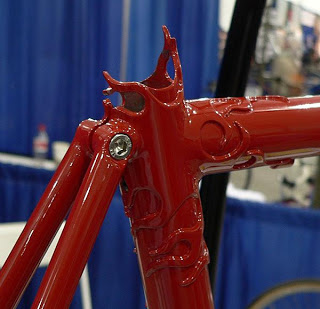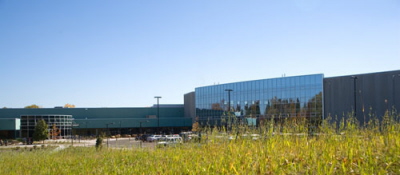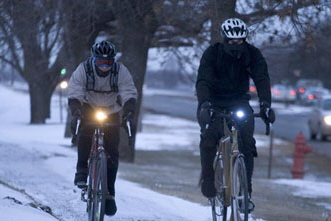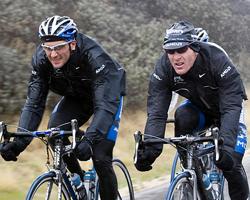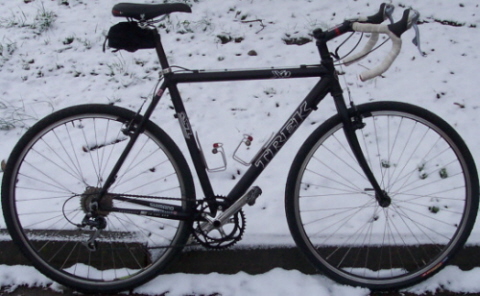So you’ve spent all summer and fall following your training schedule or working toward your goal of riding the MS150 and now that winter has come, you’re thinking “now what?”.
You’re not alone. We talk to many people every day who are in your shoes and come to us to look for the gear they need to make it through the winter and hit the road in better shape next spring. Whether you’re the hard-core rider who plans to ride outside as much as possible this winter or looking for ways to ride inside to beat the cold and darkness – we’ve got what you need. Here’s a quick and easy guide:
Inside: For those wanting to stay inside, there’s some great options.
~The stationary trainer is the most popular way to maintain fitness and your schedule. Popular models from CycleOps, Kinetic, Elite, and Blackburn will meet your needs and give you options. A stationary trainer holds your bike by the rear axle while a resistance unit attached to a roller, which contacts your rear tire, provides the workout. Varied resistance units and types of resistance are the main ways that trainers vary from each other – but “fluid” resistance trainers are the most popular and the industry standard. When buying a trainer, also consider buying a Riser Block and Trainer Mat. The riser lifts your front wheel to the same level as your rear wheel (which is elevated by the trainer) for more comfortable riding. The CycleOps Climbing Riser Block ($29.99) has three levels to accomodate different sized tires or simulate a “climbing” riding position to correctly stimulate your climbing muscle groups.
The Trainer Mat is a persperation and lube proof mat which will protect the floors of your home from the sweat, chain lube, and dirt from your bike.
In addition, one thing that has annoyed long-time, loyal indoor trainer users has been tire wear. The higher-than-normal heat on your tires from the aluminum roller of the trainer causes your rear tire to wear exceptionally fast – especially if it is a lower-quality tire. Two tips: The Elite “Elastogel” trainers replace the aluminum roller with a high density elastomer (rubber) roller which dissipates heat better, doesn’t wear out your tires, reduces tire-slippage, and can be quieter than conventional aluminum trainers. Also, Continental Tire has created a tire specifically designed for use on stationary trainers. This yellow tire uses a harder, more heat resistant rubber compound with no carbon (which makes your tires black – and what comes off your tire while riding a trainer, causing wear and covering your bike, trainer, and floor with black stuff). The Home Trainer tire ($39.99) is a popular choice for our clients who like to use higher-quality tires on the road and don’t want to wear them out on the trainer. Many people will also choose to purchase a lower-quality rear wheel and gear cluster to use with the trainer tire so that they don’t have to constantly change tires when installing or removing their bike from the stationary trainer. This “trainer wheel” is a huge time-saver and very convenient when a nice day rolls around and you want to take your bike outside for a spin.
Another great choice for folks whose schedule is better suited to indoor riding during the winter is a stationary bike – now commonly known as a “Spin” bike. Spin bikes are great if you don’t want to subject your main bike to the wear, tear, sweat, and basic punishment of the stationary trainer. The LeMond RevMaster is our best seller and is a Gym-quality spin bike (found in many YMCA’s and rec-centers) which is great for home use. It’s nearly silent operation and infinitely adjustable fit options make it perfect for your home, where it will see multiple users; usually during the kid’s nap time! Because its so quiet, it is also perfect for setting up in front of a television for watching movies, news, or using training DVD’s like Spinnervals or CTS’s series of indoor training DVD’s (both also in stock at our stores).
Giant also makes two popular models: the Turbo, a lower-cost spin bike not unlike the RevMaster; and the DualFit which is nearly identical to the ubiquitous Schwinn Airdyne – only with higher-quality parts and construction. All of these are in stock at our stores. All come fully assembled and can be delivered in the Metro-Nashville area.
Outside: Now we get to my favorite part. I love riding in the winter! Our weather is mild enough that you really can ride year-round here – with the right gear: lights and a versatile mix of clothing to respond to our unpredictable winter weather. We’re so lucky here to have the great riding available to us that Middle Tennessee is known for – and the climate to enjoy it almost year round. Here’s some of the best items you can get for your money to help you expand your riding season.
A good “base layer” is essential. Keep your core warm and the rest of you will be warmer. Our favorite is the Craft Pro Zero. This base layer is woven a special way to help eliminate “hot spots” and move your body heat more evenly around your torso to keep you warm. It’s so warm, in fact, that I can’t stand to wear mine above 50 degrees! Pearl Izumi and Descente also make great base layers.
Gloves and shoe covers are probably our best selling winter items – as these extremities are the hardest to keep warm. We’ve found that, in our climate, the most important quality for either of these items is for them to be wind-proof. In our area, the wind is what seems to be the killer when it comes to getting cold. Keep the wind off and you’ll stay warmer. We keep a good supply of wind-proof gloves and shoe covers in stock along with the popular glove-liners, “lobster gloves”, and neoprene shoe covers.
Cycling tights are essential for riding below 50 degrees. It is a commonly-held belief that below 60-70 degrees you want to cover your joints to avoid damaging them, because they actually stop lubricating themselves below a certain temperature – especially your overly-active knees. Knee-warmers are suitable for use down to about 50; and are easy to carry along and remove/put-on mid-ride. But, below 50, you might as well wear full-leg tights unless you know the weather will warm up during your ride to above 65 or 70 degrees.
Most tights are a polyester blend, which wicks well to keep you dry, with a brushed fleece lining for loft and insulation. Commonly, cycling tights will not have a cycling pad, or chamois, in them – so you’ll wear your regular riding shorts under them for comfort. Buy a really good pair of tights and they’ll last you for years. I have a pair of Pearl Izumi ThermaFleece tights that are easilly 15 years old and still in good shape.
Jackets are a great way to keep the wind off your core so you can stay warm. More versatile than a long-sleeved jersey, a wind-breaker style cycling jacket is a great piece to have if you’re taking the minimalist route to winter riding gear. The cycling-specific cut of the jackets we sell is form-fitting to keep it from flapping around as you ride and to not limit movement. Cycling jackets also have a longer cut to the back to cover your lower back while in the forward-bent riding position, protecting you from wind and any water that may spray up off your back tire. The zippered front allows for great ventilation while climbing – and is easy to zip back up for the descent. A very popular option is a jacket that converts to a vest. The sleeves are removeable and packable to allow you to customize your wardrobe to changing conditions during the season or even a single ride. The Pearl Izumi Vagabond jacket uses a one-piece removeable sleeve section to make it easy to remove mid-ride and eliminate the annoying (but inevitable) situation of losing one sleeve – rendering your jacket useless. We stock all sizes and most colors.
Now, lights. Never, ever ride after dark without proper lighting. Never. Ever. Seriously. I don’t care how reflective your helmet, jacket, tights, shoes, reflectors, bike, wheels or pale skin might be – it is not only dangerous, it’s against the law. Bikes have to follow all the same rules as cars – including proper night-time illumination. Any bicycle-specific taillight is suitable. The more expensive ones are, in fact, brighter and easier for motorists to see, but a basic $12.99 taillight will do the trick and is safer than nothing. Sigma Sport makes a micro safety light – red for the front, white for the back – which is so small, you barely notice it (the picture at left is nearly to scale…) – but when switched on, it lets cars know you’re there. It’s also perfect as a secondary light – attached to your arm, helmet, or frame – to augment your higher powered lights. They’ve become very popular in our stores.
Serious, longer-distance riders will want to consider a brighter, higher-powered, rechargeable headlight system. These are more expensive than the battery-powered lights, but offer better illumination – making it actually possible to see obstacles in the road before you’ve run over them and bent a wheel or caused a flat. The NiteRider MiNewt LED system and the Sigma Sport EVO Pro Endurance Halogen system are my personal favorites for their reasonable cost, bright and wide light pattern, long battery life and reasonable cost. Both are about $160, but the Sigma comes with two battery packs – perfect for frequent nighttime riders.
In closing – theres a lot of information I haven’t covered here. Don’t hesitate to drop in to one of our stores for answers to any of the questions you may still have. The difference you’ll find in our stores is that we actually ride in the winter and know the gear first-hand. Also, join Allanti for our cult-classic Tuesday Night Ride – only held in winter. We leave the Brentwood store every Tuesday at 7:00 p.m. for 22 miles of fun. Call for more details.
Thanks for reading!
